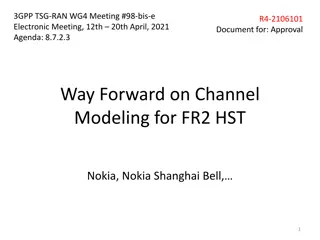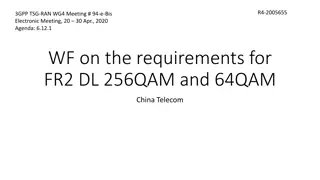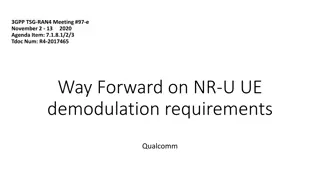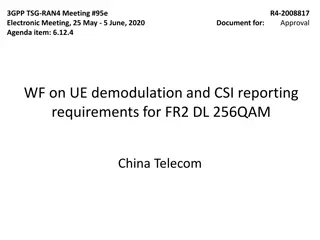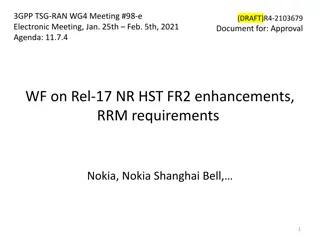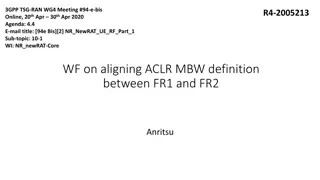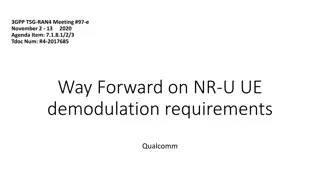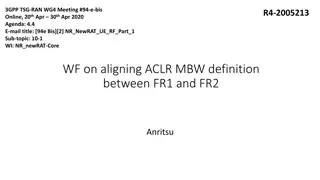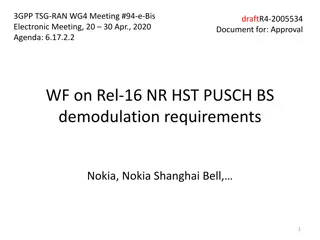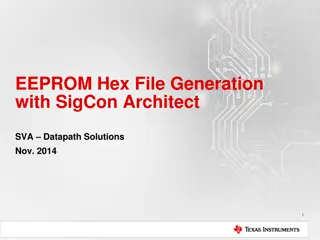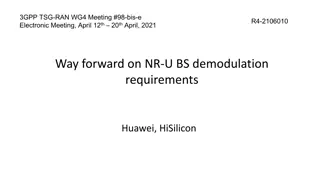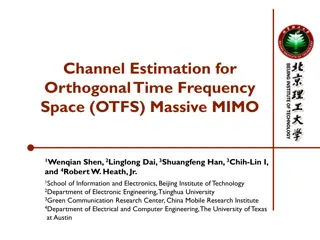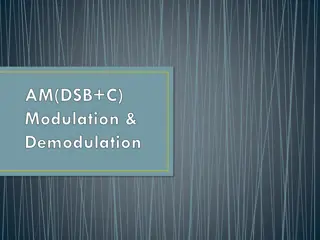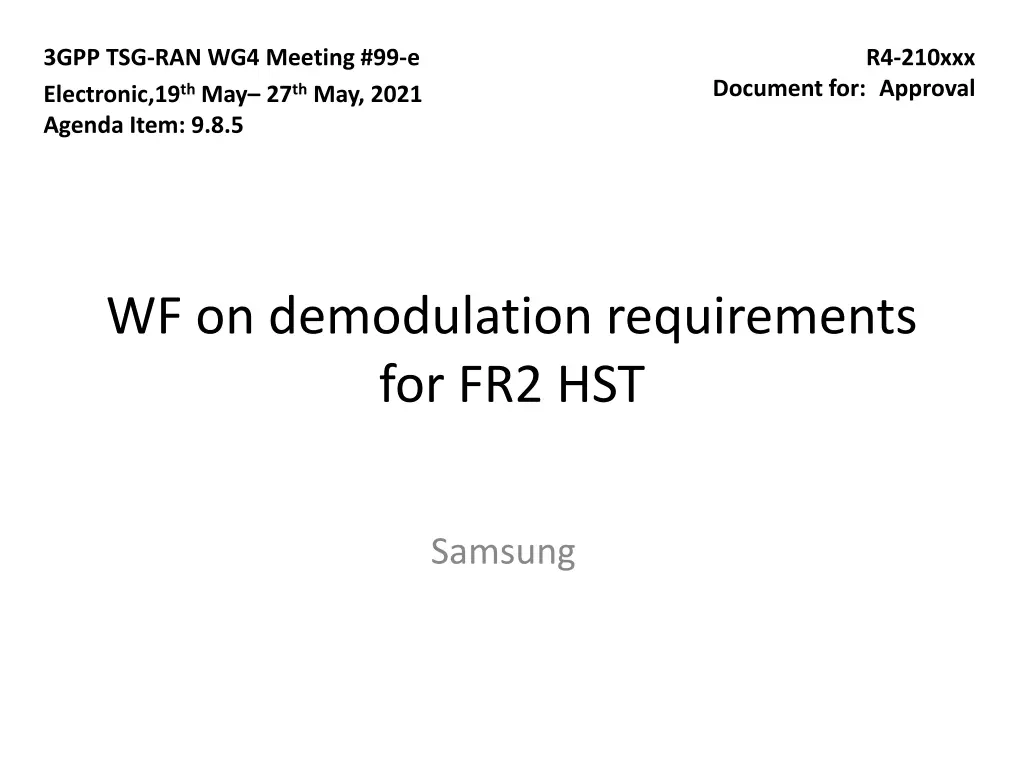
Demodulation Requirements for FR2 HST Samsung Meeting Document
Explore the demodulation requirements discussed in the 3GPP TSG-RAN WG4 Meeting #99-e for FR2 HST by Samsung. The document covers test scopes, Doppler frequency requirements, PDSCH requirements for uni/bi-directional scenarios, and more related to UE demodulation needs.
Uploaded on | 0 Views
Download Presentation

Please find below an Image/Link to download the presentation.
The content on the website is provided AS IS for your information and personal use only. It may not be sold, licensed, or shared on other websites without obtaining consent from the author. If you encounter any issues during the download, it is possible that the publisher has removed the file from their server.
You are allowed to download the files provided on this website for personal or commercial use, subject to the condition that they are used lawfully. All files are the property of their respective owners.
The content on the website is provided AS IS for your information and personal use only. It may not be sold, licensed, or shared on other websites without obtaining consent from the author.
E N D
Presentation Transcript
3GPP TSG-RAN WG4 Meeting #99-e Electronic,19th May 27th May, 2021 Agenda Item: 9.8.5 R4-210xxx Document for: Approval WF on demodulation requirements for FR2 HST Samsung
Background Agreed WFs for FR2 HST WI in previous meetings R4-2017828, WF on NR support for HST in FR2 , Samsung. RAN4#97-e meeting R4-2103240, WF on Deployment Scenario and UE RF Requirement for FR2 HST , Samsung. RAN4#98-e meeting R4-2106100, WF on FR2 HST Deployment scenario Analysis , Samsung, RAN4#98b-e meeting R4-2106101, WF on Channel Modeling for FR2 HST , Nokia, RAN4#98b-e meeting R4-2106102, WF on Demodulation requirement for FR2 HST , Samsung, RAN4#98b-e meeting 2
UE demodulation requirements
Test Scope Doppler frequency for PDSCH requirement Doppler frequency for PDSCH requirement in Bi-directional deployment scenario, if Bi- directional deployment scenario is introduced Option 1: 9722Hz targeting 350km/h at 30GHz Option 2: 7000Hz with the smallest RS range of frequency offset estimation Doppler frequency for PDSCH requirement in Uni-directional deployment scenario, if Uni - directional deployment scenario is introduced 9722Hz targeting 350km/h at 30GHz Whether to introduce PDSCH requirement with HST single-tap channel Option 1 (Samsung, Huawei, Qualcomm, Intel): Do not define PDSCH requirement with HST single-tap channel Option 2 (Ericsson, Intel): Define PDSDH requirement with HST single-tap channel (Uni- directional) with scenario A 4
Test Scope PDSCH requirement for Uni/Bi-directional scenario in scenario A and scenario B Option 1(Samsung): Define PDSCH requirement with Uni/Bi-directional scenario for both A and B, Define the test applicability rule to reduce the test effort Option 2 (Huawei): Define requirements for both scenario A/B, and Uni/Bi- directional deployment, and not define any applicability between Option 3 (ZTE): Consider output of FR2 HST deployment scenario discussion whether to cover scenario A Option 4 (Ericsson): RAN4 define two test cases for HST FR2 Test 1: HST single tap (Uni-directional) with scenario A Test 2: DPS (Uni-directional) with scenario B If RAN4 agree to consider both Uni-directional and Bi-directional deployment, either test 1 or 2 apply Bi-directional model 5
Test Scope DPS transmission scheme Option 1(Samsung): Define PDSCH requirement with DPS scheme 1a in Uni-directional scenario for scenario A. FFS scheme 1b Define PDSCH requirement with DPS scheme 1a and 1b in Uni-directional scenario for scenario B, FFS the number of TCI state configured Define PDSCH requirement with DPS scheme 1a in Bi-directional scenario for scenario A and scenario B. FFS scheme 1b Option 2 (Huawei): Define both DPS transmission scheme 1a and 1b for both Bi- directional and Uni-directional deployment Option 2a (Ericsson, Intel, Huawei): RAN4 define both scheme 1a and 1b if the performance is same, but define the same applicability rule as Rel-16 HST, i.e., if a UE declared supporting > 1 TCI states, the UE will pass scheme 1b and skipped scheme 1a test cases, and if a UE only support 1 TCI state, the UE need to pass scheme 1a and skip scheme 1b test cases. Option 3 (ZTE): DPS scheme 1a could be considered in Uni-directional RRH scenario If another panel cannot be used for beam search, scheme 1a could be considered in Bi- directional scenario. If another panel can be used for beam search, both scheme 1a and 1b could be considered in Bi-directional scenario. 6
Test Setup for PDSCH RS configuration Assumption of RS for frequency offset tracking is up to UE implementation, FFS the RS configuration for PDSCH requirement as Configure SSB every 20ms Configure TRS every 10ms Configure PTRS with KPT-RSS=2 and LPT-RS=1 DMRS configuration Option 1(Samsung, Intel, Qualcomm, Huawei): 1+1+1 DMRS configuration for DPS scheme Option 2 (Ericsson, ZTE): 1 DMRS for HST single-tap channel 1+1+1 DMRS configuration for HST DPS CBW Option 1(Samsung. Ericsson, Qualcomm, Intel): 100MHz CBW Option 2 (Huawei, Intel, ZTE): 200MHz CBW Option 3 (Intel): Align the CBW configuration for PDSCH and PUSCH UE frequency error Do not consider extra UE frequency error for demodulation tests in FR2 HST WI Impact of UE frequency error can be included in companies impairment results when RAN4 sets the UE demodulation requirement for FR2 HST 7
BS demodulation requirements
Test Scope PUSCH requirement Introduce PUSCH requirement with Doppler frequency as 19444Hz targeting 350km/h at 30GHz Do not introduce PUSCH requirement with Doppler frequency as 14444Hz targeting 260km/h at 30GHz, if no issue with supporting 350km/h was identified 9
Test Scope PUSCH requirement for Uni/Bi-directional RRH deployment scenarios in scenarios A and B Option 1 (Samsung): Define PUSCH requirement with Uni-directional RRH deployment scenario only in scenario A. If both scenarios are introduced for PUSCH requirements, define the test applicability rule to reduce the test effort with only one of them will be selected for testing based on manufacture of declaration. If both scenarios A and B for bi-directional RRH deployment scenario are introduced for PUSCH requirements, define the test applicability rule to reduce the test effort with only one of them will be selected for testing based on manufacture of declaration Option 2 (Nokia): RAN4 to define different sets of requirements for Scenario A and Scenario B If it is decided that single HST conditions are not sufficient for HST FR2, then to define both PUSCH demodulation requirements for Uni- and bi-directional RRH deployment scenarios Option 3 (Ericsson): Define test cases for scenario A only Option 4 (Huawei): Define requirements for both scenario A/B and Uni/Bi- directional deployment, and not define any applicability rule between them. Manufacture declaration can be used and the case will be tested only when BS vender declares to support it. 10
Test Setup for PUSCH requirements RS configuration Option 1(Samsung, Ericsson, ZTE): 1 DMRS +PTRS (L=1,K=2) Option 2(Nokia, Intel): 2 DMRS+ PTRS (L=1,K=2) Option 3(Huawei, Nokia): 3 DMRS +PTRS (L=1,K=2) Option 3a: If companies have strong concern about DMRS 1+1, create an applicability rule that only one DMRS configuration shall be tested by manufacture declaration CBW Option 1: 100MHz, and 50MHz with test applicable rule (Samsung, Nokia) Option 2: 200MHz, and 50MHz with test applicable rule (Samsung, Nokia) Option 3: 100MHz only (Intel, Ericsson) Option 4: 200MHz only (Huawei, Intel, ZTE) MCS Option 1(Samsung, Huawei, Nokia): MCS 16 Option 1a(Samsung): Additional margin can be considered for performance requirement definition to allow different implementation if needed Option 2 (Intel): both MCS 16 and MCS 17 Define requirements with MCS17 up to BS declaration support Option 3(Ericsson): Configure highest MCS that remains below 20dB SNR, i.e, MCS20 Further discuss how to guarantee 64QAM operation Further discuss how to not preclude any possible BS implementations (with pre and post FFT FOC) Length of data symbol Option 1 (Samsung, Nokia, Intel): 9 Option 2 (Huawei, Intel, Ericsson): 10 11
Test Setup for UL timing adjustment Waveform CP-OFDM CBW Align CBW for UL adjustment and PUSCH demodulation Option 1: 100MHz, and 50MHz with test applicable rule (Samsung, Nokia) Option 2: 200MHz, and 50MHz with test applicable rule (Samsung, Nokia) Option 3: 100MHz only (Intel, Ericsson) Option 4: 200MHz only (Huawei, Intel, ZTE) PUSCH resource allocation Option 1(Samsung) Moving UE: 0~32 for 100 MHz CBW, FFS 0~15 for 50 MHz CBW Stationary UE: 33~65 for 100MHz CBW, FFS 16~31 for 50MHz CBW Option 2 (Ericsson): Align CBW for UL timing adjustment and PUSCH demodulation Moving UE: 0~32 for 100 MHz CBW Stationary UE: 33~65 for 100MHz CBW Option 3(Nokia, Huawei): Moving UE: 0~65 for 200 MHz CBW Stationary UE: 66~131 for 200 MHz CBW RS configuration Option 1 (Samsung, Ericsson, ZTE): 1 DMRS+PTRS (L=1,K=2) Option 2 (Nokia, Intel): 2 DMRS+PTRS (L=1,K=2) Option 3 (Huawei, Nokia): 3 DMRS+ PTRS (L=1,K=2) 12
Test Setup for UL timing adjustment requirement PUSCH mapping type Type B Length of PUSCH allocation Align with PUSCH for UL timing adjustment Option 1: 10 Option 2: 9 MCS Align with PUSCH for UL timing adjustment Option 1(Samsung, Huawei, Nokia): MCS16 Option 1a(Samsung): Additional margin can be considered for performance requirement definition to allow different implementation if needed Option 2 (Intel): both MCS16 and MCS17 Define requirements with MCS17 up to BS declaration support Option 3 (Ericsson):Align MCS for UL timing adjustment and PUSCH demodulation requirement, configure highest MCS that remains blow 20dB SNR, i.e., MCS20 13
Test Setup for UL timing adjustment requirement SRS bandwidth configuration Option 1(Samsung, Nokia): Option 1a (Samsung): C_SRS =11, B_SRS =0 for 40RB, with 100 MHz CBW C_SRS = 5, B_SRS=0 for 20RB, with 50 MHz CBW Option 1b (Nokia): C_SRS =9, B_SRS =0 for 32RB, with 100 MHz CBW Option 1c (Ericsson): C_SRS =17, B_SRS =0 for 64RB, with 100 MHz CBW C_SRS = 9, B_SRS=0 for 32 RB, with 50 MHz CBW Option 2(Huawei, Nokia): C_SRS=33, B_SRS=0 for 132RB with 200MHz CBW SRS Transmission comb: KTC=2 SRS Transmission periodicity : KSRS=10 Slots in which sounding RS is transmitted The last symbol in slot#3 in radio frames for 120KHz SCS Test Parameters for timing offset Option 1(Nokia, Huawei, Ericsson, Intel): A: 1.25 us w: 1.04 s-1 Option 2(Samsung): FFS on A =2.5 us Test Parameters for timing offset Option 1(Samsung, Huawei, Intel, Ericsson, Nokia): [ t-(TA-31)x16*8Tc] Note: The timing different can be updated with taken into account the output of possible enhancements for timing adjustment command discussion in RRM session 14
Test setup for PRACH Frequency offset 19444Hz with 350km/h at 30GHz carrier frequency Test Preamble Configuration for Ncs Option 1: Ncs=69 (Nokia) Option 2: Ncs=0 as baseline (Ericsson, Huawei, Intel, Samsung) Test offset configuration Option 1: Reuse Rel-15 FR2 timing offset configuration for PRACH, i.e., 0.8us (Huawei, Nokia, Ericsson) Option 2: Update the timing offset configuration based on the largest expected cell radius, i.e., derived from scenario B, (Ericsson) Note Scenario A (Ds=700m, Dmin=10m), cell radius = 700m Scenario B (Ds=700m, Dmin=150ms), cell radius = 716ms Test offset configuration 0.07us for AWGN 15
Testability issues for FR2 HST UE Option 1: Do not discuss any testability issue aspects in HST FR2 WI unless it is captured in WID Option 2 (Huawei, Qualcomm): Assume static UE and single Probe. Option 3: (Huawei) Combine RRM and Demod requirements as a single feature to support HST FR2 operation 17
Observations (information) RS configuration to enable 350km/h for PDSCH Observation 1 (Intel) When UE is served by one RRH the Doppler frequency trajectory is continuous and there are no problems to track it by TRS To performance switching from one RRH to another UE needs to handle frequency jump which is different for different deployments scenarios. For unidirectional it can be up to max Doppler frequency and in bidirectional up to double max Doppler frequency Observation 2 (Qualcomm) Maximum Doppler frequency based on TRS is 14000Hz if we do not assume frequency error Assuming zero frequency error, the range of maximum Doppler frequency estimation based on TRS is 14kHz In a bidirectional deployment, if Fc=30GHz and the train speed is 350 Km/h, a UE using TRS processing for frequency offset tracking will experience a maximum Doppler shift larger than 19kHz when switching between RRHs pointed in opposite directions, outside of the TRS range and the impact on performance is potentially unbounded. Using both SSB and TRS for UE Frequency Offset Tracking does not solve the problem of the maximum Doppler shift larger than TRS FO estimation range, if the first resource received at the UE after the switch to a new RRH is TRS and not SSB Combining different resources (with different spectral characteristics as in the case of SSB and TRS) for FOT requires a dedicated UE implementation. Feasibility of supporting maximum speed of 350km/h in downlink using TRS (4 symbol interval) and SSB for frequency offset tracking under bi-directional RRH deployment, assumes an increased complexity in the UE implementation of FOT schemes compared to a baseline UE implementation. Observation 3 (Ericsson) Maximum Doppler frequency based on TRS is 14000Hz if we do not assume frequency error Maximum Doppler frequency based on TRS is 11,000Hz if we assume frequency error of 0.1ppm at 30GHz. 18
Observations (information) PUSCH requirement for Uni/Bi-directional RRH deployment scenarios in scenarios A and B Observation 1 Similar performance can be achieved for both bi-directional and un-directional deployment scenario in scenario A Similar performance can be achieved for Uni-directional scenario in scenario A and B Better performance can be achieved for bi-directional scenario in scenario B compared with Uni-directional scenario Observation 2 The difference in SINR values corresponding to 30% and 70% of PUSCH maximum TPut with the same test configuration in Scenario A and Scenario B is less than 0.3 dB. Scenario B looks to be slightly less challenging because the same relative TPut levels can be achieved at a bit lower SINR. The difference in SINR values corresponding to 30% and 70% of PUSCH maximum TPut with the same test configuration in Uni- and bi-directional deployments is less than 0.1 dB The Uni-directional and bi-directional scenarios are fundamentally different from the Doppler trajectory point of view 19
Observations (information) RS configuration for PUSCH Observation 1 (Samsung) The overhead of 1DMRS +PTRS (L=1, K=2) configuration is the smallest compared with other RS configuration schemes With 1 DMRS+PTRS (L=1, K=2) configuration, better performance can be achieved in terms of maximum throughput compared with other RS configurations Observation 2 (Ericsson) The performance difference is negligible for PUSCH configured with PT-RS +(1+0) DM-RS and PT-RS + (1+1) DM-RS symbols Observation 3 (Huawei) There is negligible performance difference between DMRS 1+1 and DMRS 1+1+1. There is about 1.2dB performance degradation between DMRS 1 and the others due to large residual frequency offset using PTRS only for frequency offset estimation. Observation 4 (Nokia) There is no significant difference in the demodulation performance between the cases with only one and two DM-RS per slot when PT-RS is present. We can expect a similar behaviour when two additional DM-RS symbols are used. It is practical to use at least one additional DM-RS symbol per slot in real implementation where fast fading is inevitably present. Moreover, in HST FR1 PUSCH requirements two additional DM-RS symbols are used 20
Contributions List in RAN4#99-e T-doc No. R4-2109216 R4-2109217 R4-2109749 R4-2109750 R4-2109805 Title View on DL demodulation requirements for HST FR2 View on UL demodulation requirements for HST FR2 Discussion on Reference Signal for UL and DL Discussion on UE Demodulation Requirements for FR2 HST View on demodulation requirement for Rel-17 FR2 HST Company Intel Corporation Intel Corporation ZTE Corporation ZTE Corporation Samsung R4-2109806 R4-2109807 R4-2110530 R4-2110531 R4-2110532 R4-2110643 R4-2110720 View on BS demodulation requirement for Rel-17 FR2 HST View on UE demodulation requirement for Rel-17 FR2 HST Discussion on BS demodulation requirements for FR2 HST Discussion on UE demodulation requirements for FR2 HST Discussion on general issues for NR FR2 HST demodulation requirements UE demodulation requirements for HST FR2 Maximum UE velocity and RS configuration for FR2 HST UE Demod Performance Test BS demodulation requirements for HST FR2 On HST FR2 BS Demodulation Requirements On HST FR2 DM-RS Configuration in UL Direction Samsung Samsung Huawei, HiSilicon Huawei, HiSilicon Huawei, HiSilicon Ericsson Qualcomm Incorporated R4-2110730 R4-2111067 R4-2111108 Ericsson Nokia, Nokia Shanghai Bell Nokia, Nokia Shanghai Bell 21
Reference [1] R4-2108454, Email discussion summary for [99-e][329] NR_HST_FR2_Demod , Samsung 22

